Most light sources emit a broad range of wavelengths that cover the entire visible light spectrum. In many instances, however, it is desirable to produce light that has a restricted wavelength spectrum. This can be easily accomplished through the use of specialized filters that transmit some wavelengths and selectively absorb or reflect unwanted wavelengths.
Color filters are usually constructed using transparent pieces of dyed glass, plastic, lacquered gelatin (e.g. Wratten filters) that have been treated to selectively transmit the desired wavelengths while restricting others. The two most common types of filters in use today are absorption filters that absorb unwanted wavelengths and interference filters that remove selected wavelengths by internal destructive interference and reflection. In any filter, a small amount of the incident light is reflected from the surface regardless of the filter construction and a small portion of the light is also absorbed. However, these artifacts are usually very minimal and do not interfere with the primary function of the filter.
Absorption Filters - These filters are generally constructed of dyed glass, lacquered gelatin, or synthetic polymers (plastics) and have a wide range of applications. They are used to create special effects in a number of photography applications and are widely employed in the cinema industry. In addition, absorption filters are commonly found in signs and traffic signals and as directional signals on automobiles, boats, and airplanes. The diagram below (Figure 1) illustrates a magenta filter that is designed to adapt to a camera lens. We have also constructed an interactive Java tutorial that describes how lacquered gelatin and glass filters work.
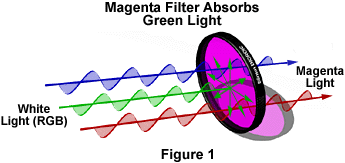
In Figure 1, the three incident waves are colored red, green, and blue but are intended to represent all the colors that comprise white light. The filter selectively transmits the red and blue portions of the incident white light spectrum, but absorbs most of the green wavelengths. As discussed in our section on primary colors, the color magenta is obtained by subtracting green from white light. The light-modulating properties of a typical color filter are illustrated in Figure 2. In this case we are examining a color correction filter that adds a factor of 50 color compensating (cc) units to incident light. The details of color correction filters will be discussed in the color correction section below.
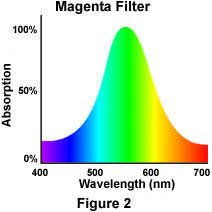
In Figure 2 above, absorption is plotted against the visible wavelengths that are passed through the magenta filter. The peak intensity of absorbed light falls at about 550 nanometers, right in the center of the green region of visible wavelengths. The filter also absorbs some light in the blue and red regions, indicating this filter is not perfect and a small portion of all wavelengths do not pass through. A perfect filter would have a very sharp peak centered in the green region that trailed off to zero absorption at non-green wavelengths, but this is all but impossible to accomplish with real-world visible absorption filters that can be manufactured at reasonable prices. This type of unwanted absorption is often termed secondary absorption and is common to most filters.
Absorption Filters
Explore how gelatin and glass absorption filters are used to pass a specific band of wavelengths.
Interference Filters - These filters differ from absorption filters in the fact that they reflect and destructively interfere with unwanted wavelengths as opposed to absorbing them. The term dichroic arises from the fact that the filter appears one color under illumination with transmitted light and another with reflected light. In the case of the magenta dichroic filter illustrated below in Figure 3, green light is reflected from the face of the filter and magenta light is transmitted from the other side of the filter.
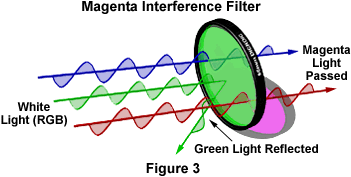
Dichroic filters are manufactured using multi-layered thin film coatings that are deposited onto optical-grade glass using vacuum deposition. These filters have four basic design types: short wavelength pass, long wavelength pass, bandpass and notch filters. Dichroic filters are far more accurate and efficient in their ability to block unwanted wavelengths when compared to gel and glass absorption filters. Short and long wavelength pass dichroic filters act as the names imply and allow transmission of only narrow bands of short or long wavelengths, reflecting the unwanted wavelengths. Bandpass dichroic filters are the most common and are designed to transmit selected wavelengths in the visible region. The diagram below (Figure 4) illustrates the transmission spectrum of a typical bandpass dichroic filter.
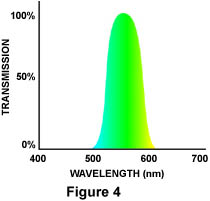
In this graph we have plotted the wavelengths that are transmitted by the filter versus the percentage of transmission. Note that the wavelength maximum is at 550 nanometers--right in the center of the green region. This filter is much more effective than the glass or lacquered gel magenta filter discussed above because there is virtually no passage of unwanted wavelengths and secondary transmission is almost nonexistent. The final type of dichroic filters are known as notch wavelength filters, which operate by "notching out" or eliminating unwanted wavelengths. Notch filters are effectively the opposite of bandpass dichroic filters. To use the example illustrated in the plot, a notch filter would pass the red and blue color wavelengths that are blocked with the bandpass filter.
Dichroic filters are commonly used for a number of applications including specialized filtration for optical microscopy and photography. High-quality color enlargers employ dichroic filters (instead of absorption filters) to finely tune the color of light that is passed through the color negative or transparency. This allows the photographer a high degree of color correction control over photographic prints.
Color Correction - Photographers and microscopists often must make slight corrections in the color of the illumination in photographic enlargers and microscope optical paths to insure accurate color rendition. This is usually done with Kodak Color Compensation (abbreviated CC) filters that can be placed in the light path of the enlarger or microscope. Although we refer to the Kodak filters here, there are a wide variety of manufacturers that produce these filters made with dyed gels or dichroic glass. These filters are labeled with a number that corresponds to the filter's light-absorbing ability, typically in the somewhat arbitrary range of 05, 10, 20, 30, 40, and 50 as illustrated in the table below for cyan filters.
| Filter Designation | Light Transmitted | Approximate Transmission | Peak Filter Density |
|---|---|---|---|
| 05 (CC05C) | 8.9 units | 89% | 0.05 |
| 10 (CC10C) | 7.9 units | 79% | 0.10 |
| 20 (CC20C) | 6.3 units | 63% | 0.20 |
| 30 (CC30C) | 5 units | 50% | 0.30 |
| 40 (CC40C) | 4 units | 40% | 0.40 |
| 50 (CC50C) | 3.2 units | 32% | 0.50 |
Table 1
As the numbers increase, more light is absorbed because the filters are increasingly darker. In the example above, a cyan filter range from 05 to 50 is featured where the background color for the table corresponds to the approximate filter color. The 30 cyan filter (referred to as a CC50C (cyan) filter) reduces the intensity of the complementary color by 50% or one exposure step (f-stop). The CC filters are available as Wratten filters (sized at 2" × 2" or 3" × 3") in 6 different colors: blue, yellow, green, magenta, cyan and red and in several densities (as illustrated in Tables 1 and 2). The easiest way to remember their use is to consult the "color compensating triangle", shown in Figure 5 below.
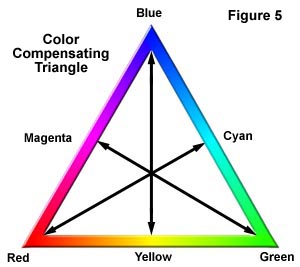
Just follow the arrows from vertex to opposite side or from side to opposite vertex. You can also refer to Table 2 for the correct CC filter color. For example, a green cast is removed by use of a CC magenta filter. The appropriate density of the chosen CC filter has to be determined by test exposures. See John Delly's "Photography Through The Microscope" for color illustrations of color casts.
| Color to be reduced | Color compensating | Filter required |
|---|---|---|
| Blue | Yellow | CCY |
| Cyan | Red | CCR |
| Green | Magenta | CCM |
| Yellow | Blue | CCB |
| Red | Cyan | CCC |
| Magenta | Green | CCG |
Table 2
When conducting experiments involving photomicrography (photography through the microscope) we often add color compensating filters into the light path. This is most easily accomplished by shaping the filter into a circle with scissors and inserting into the light path just behind the diffusion filter. Alternatively, Kodak sells small metal frames that hold Wratten filters which can be placed on the light port of the microscope just above the field diaphragm. This allows for a global color correction in the resulting photomicrographs.



